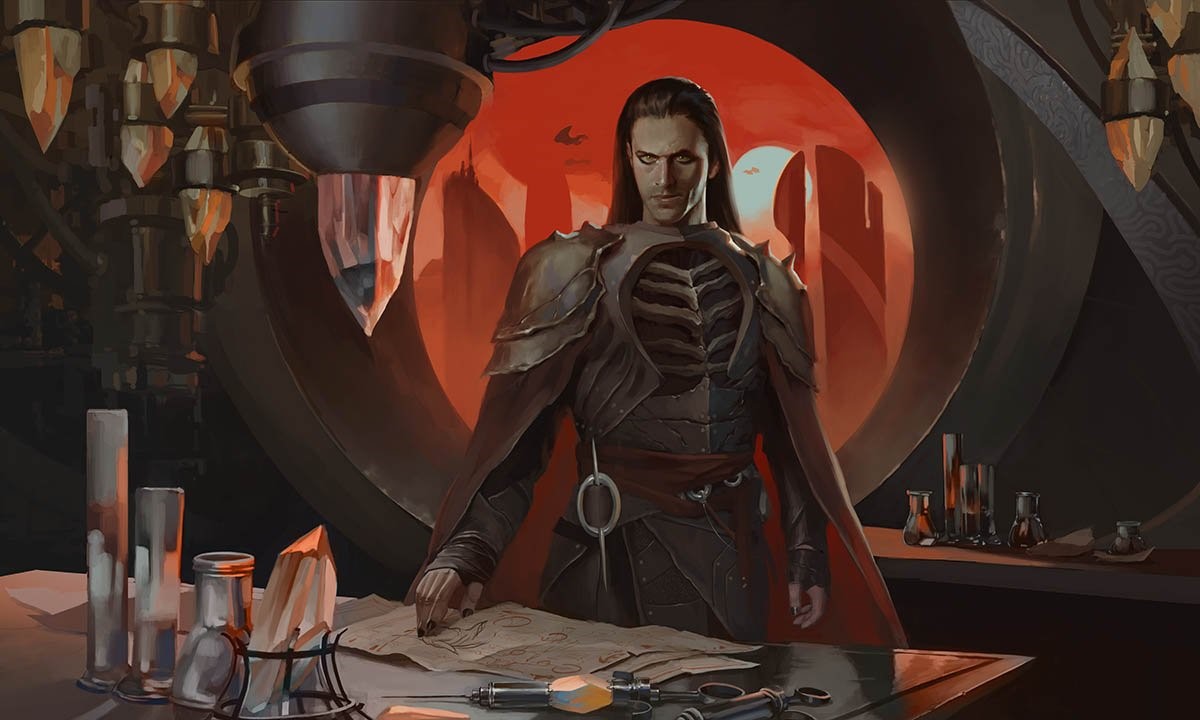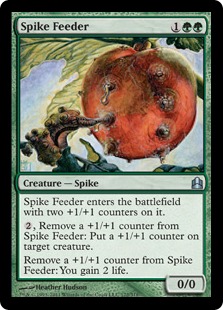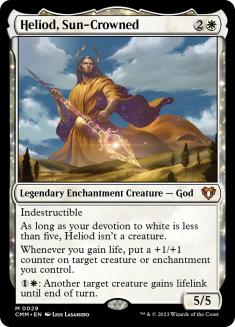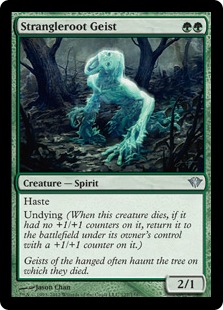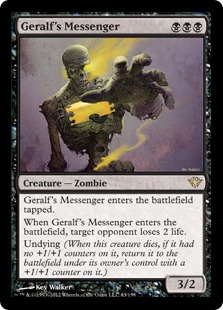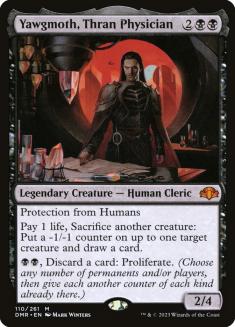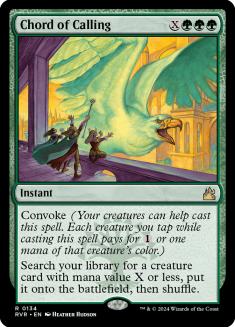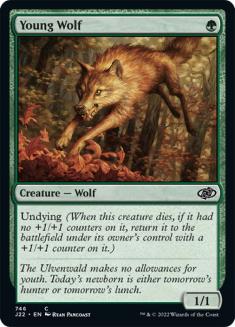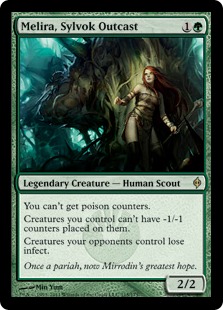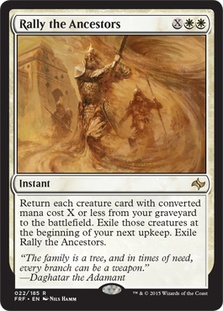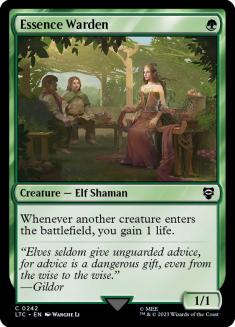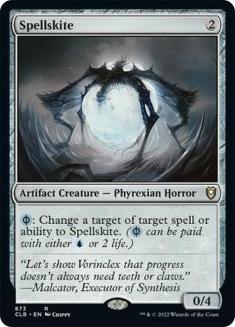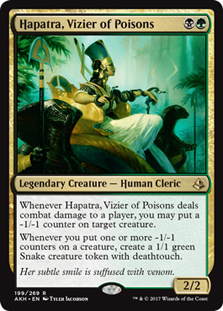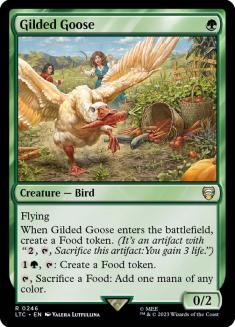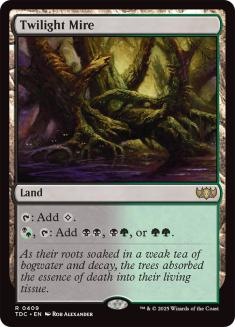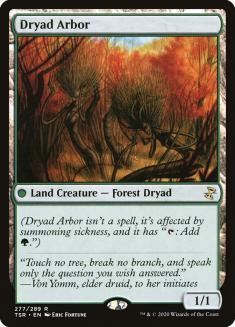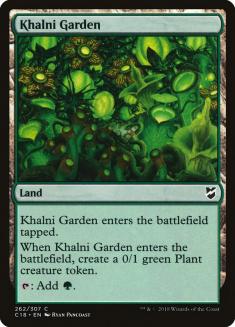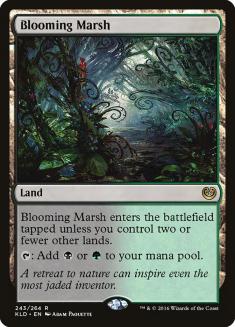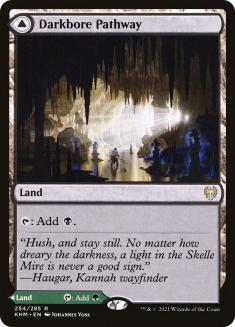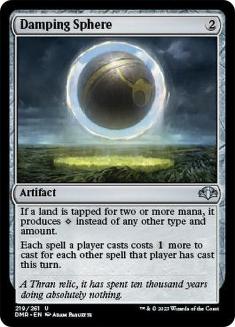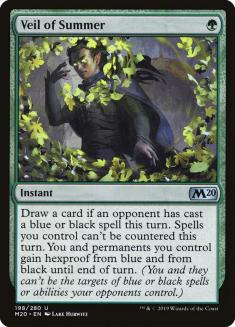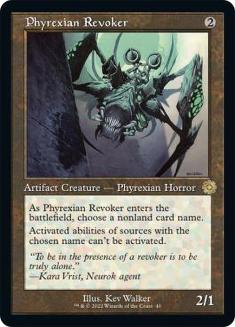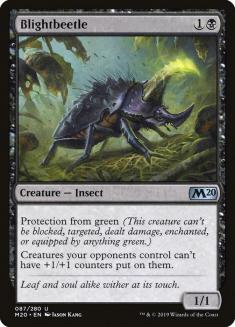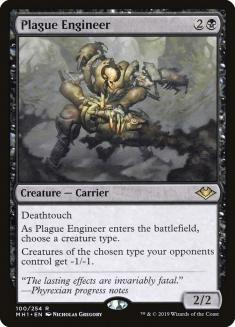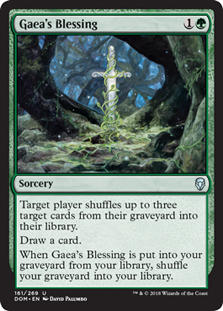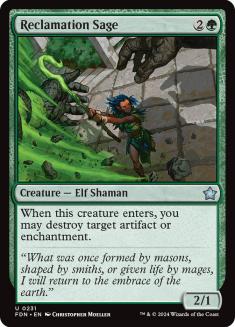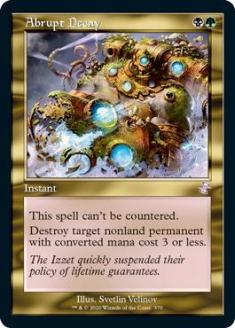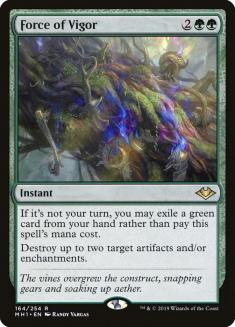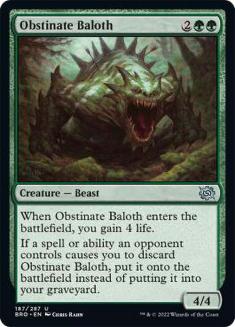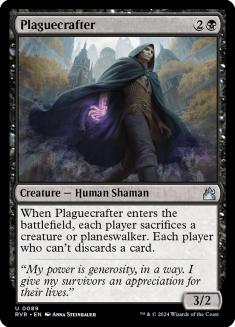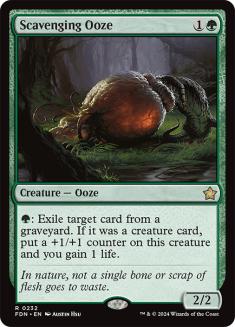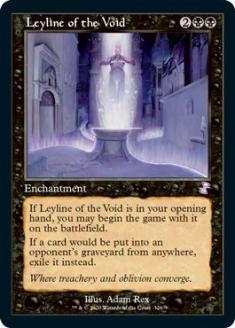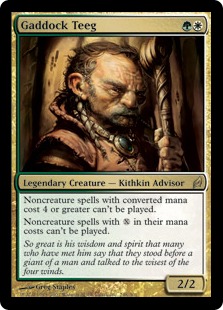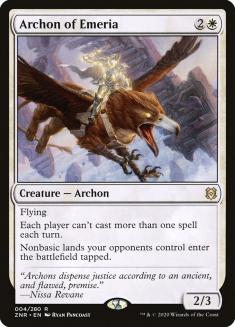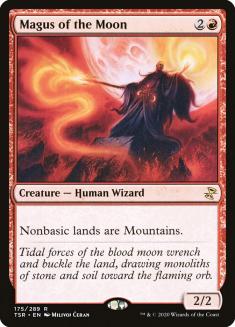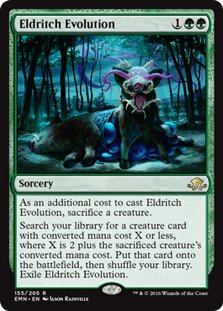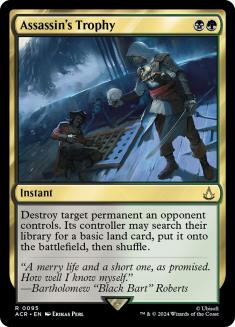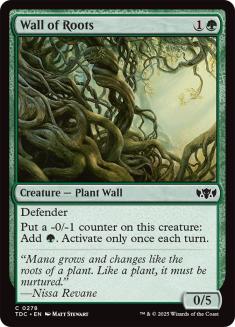Golgari Yawgmoth had a nice run to start 2020 thanks to Aaron Barich, but it’s hard to compare now and then. Once Upon a Time was legal and in the deck; Oko, Thief of Crowns was legal for some these events; the events were held in paper. May as well be talking about who wins the U/G Madness versus Goblin Bidding matchup at this point.
Creatures (30)
- 4 Birds of Paradise
- 4 Wall of Roots
- 1 Essence Warden
- 1 Noble Hierarch
- 1 Spellskite
- 4 Strangleroot Geist
- 4 Geralf's Messenger
- 4 Young Wolf
- 1 Zulaport Cutthroat
- 1 Hapatra, Vizier of Poisons
- 4 Yawgmoth, Thran Physician
- 1 Gilded Goose
Lands (20)
Spells (10)

More recent and relevant is its wave of success sparked by a Challenge Top 8 by CitrusD, aka Tom Ross. Tom worked on the deck with Aaron last year, so sticking with it post-Uro makes sense.
Except…. does it?
Usually when I write about a Modern deck, I’m trying to answer a question. This week, that question was, “Why would you play Golgari Yawgmoth over Selesnya Company?”
Just looking at the two decks, there are many good arguments to play with Heliod, Sun-Crowned over Yawgmoth, Thran Physician. Heliod has the whole indestructible, noncreature enchantment thing. The Yawgmoth combo is really a three- or four-card setup with life total conditions, where Heliod is a clean two-card combo. The “filler” in Heliod is game-dominating cards like Skyclave Apparition and Auriok Champion, where Yawgmoth’s filler is do-nothing Wall of Roots and beatdown creatures that weren’t good enough for Standard in 2011.
But here’s another peek behind the curtain of my writing process. When the answer to “Why is this happening?” is just “random chance, this deck is bad”, I don’t write about it.
There is real merit to Golgari Yawgmoth in Modern these days.
The Ins and Outs of Golgari Yawgmoth
Aaron Barich covered a solid amount of playing the deck in her article last year. I’ll expand on that for the current era.
To quickly spell out the combo: if you control Yawgmoth, Thran Physician and two undying creatures, one without a +1/+1 counter and one in whatever state, you can sacrifice them back and forth. Sacrifice the fresh one to put a -1/-1 counter on the one with a +1/+1 counter. It comes back from undying, and the plus and minus counters on the other cancel out, putting you back where you started with one fresh undying creature, one with a counter, down a life, and up a card.
If one of those creatures is Geralf’s Messenger, every two sacrifices, you and your opponent both lose two life; two Geralf’s Messengers, and they lose four to your two. If you have a Blood Artist or Zulaport Cutthroat, any two undying creatures let you drain their life total if it is less than the number cards in your deck.
Short-Comboing
One of the more important aspects of this deck is short-comboing. If you have a double Young Wolf combo that doesn’t kill your opponent, you are still paying a life to draw a card as many times as you want. That can lead to a Chord of Calling that finds the piece to make a true infinite, or just enough cards that you can pass the turn and not really care if they kill your on-battlefield Yawgmoth.
You can also use a single undying creature in a similar fashion with other non-undying creatures. Sacrifice your Young Wolf, next sacrifice a Birds of Paradise to put a -1/-1 counter on it, then sacrifice the original Young Wolf again, and you have some real Skullclamp action where all your random bodies turn into two cards.
If Selesnya Company is good against grindy decks because they just can’t kill its core threat of Heliod, Sun-Crowned, Yawgmoth is good against grindy decks because you have simple ways to bury them in cardboard.
There’s also a bit of that same can’t-kill-my-stuff attitude here, since throwing removal at undying creatures is a losing proposition. Path to Exile levels are low in the metagame, leading to lots of “Fatal Push your Strangleroot Geist, I guess.” Instead of them never killing your Heliod and you always threatening a kill with Spike Feeder, they can’t effectively clean up your random trash and a resolved Yawgmoth always threatens to run away with the game.
That poor lineup between Fatal Push and Geralf’s Messenger also means you get a lot of beatdown equity. That’s right, Cedric: attacking with Geralf’s Messenger is finally good in 2021. In a lot of games you technically combo-kill them, but if Yawgmoth was something stupid like Questing Beast, you probably would have killed them too.
To pin Golgari Yawgmoth’s play patterns to some older archetypes, it combines the sequencing-heavy creature combo aspects of Abzan Company from the Melira, Sylvok Outcast VS Thought-Knot Seer era with the Standard Rally the Ancestors plan of applying random pressure that kills your opponent some of the time, but really just forces them to act and runs them out of resources or mana to stop your bigger combo kill.
I say this because I know those decks have quite the fan following. Selesnya Company offers similar play, but if you want an even more concentrated Rally-Melira experience, try out Golgari Yawgmoth.
So What’s Changed?
The only real changes to the deck in the last year were mostly forced by the banning of Once Upon a Time, which has really just led to an expansion of the tutor toolbox.
The big addition in my eyes has been Essence Warden. I mentioned the “non-lethal loop drawing into Chord of Calling” play, and Essence Warden is the most efficient card to have access to for this setup. You don’t always have a ton of untapped creatures to cast the Chord for Zulaport Cutthroat, especially if one of your undying creatures is Geralf’s Messenger that returns tapped, or sometimes you accidentally draw the Chord target and have to cast it from hand. Warden dropping that cost to cast or Chord to the bare minimum is a game-changer. So is giving you a backup when drawn.
I’m less excited by the other tutor slots.
Spellskite isn’t terrible. You have some of the same setup insulation for the combo as Heliod does, since having a third undying creature lets you recombo in response to removal, but Spellskite can often tank multiple red removal spells at once or save your smaller stuff from Lava Dart early. Certainly a negotiable slot.
Hapatra, Vizier of Poisons does a bunch of really cute things. It’s almost a self-contained combo with Yawgmoth, since each sacrifice generates a new Snake to sacrifice off the -1/-1 counter. That either can go until you run out of places to put the counters (Yawgmoth has protection from itself, so don’t try that) or with an undying creature loop until you run out of life like the double-undying combo. If you get the double-undying creature combo with Hapatra, it’s sorta like an Essence Warden or Zulaport Cutthroat since you make a Snake each loop, which probably turns into a kill next turn.
But all that said, I’m not sure I really want Hapatra in the deck. It reminds me a lot of Conclave Mentor in the Selesnya Company deck, where it’s another layer of combo that doesn’t have the same resilience or utility as your other pieces, except here you just have a million undying cards you could play instead. It feels like the card’s role is entirely tied to how often you want to use it with Yawgmoth as a simple setup to machine-gun down the battlefield of some creature deck that isn’t pressuring your life total, which right now is basically just Selesnya Company and maybe locking out Amulet Titan. As with Spellskite I don’t hate it, but I think a different tutor target might be more effective.
I’ll need an adult to explain Gilded Goose to me. It’s a terrible mana creature in a deck trying to maximize mana in each of its early turns. It’s also a worse lifegain effect than Essence Warden. Just play a land instead.
On the subject of lands, that might be where Once Upon a Time was helping the deck the most. Twilight Mire is the peak of this, where you need to play four copies in your Strangleroot Geist into Geralf’s Messenger deck but also are at risk of drawing double Mire hands. Add the extra pressure on your Birds of Paradise due to more Lava Darts, and a 23rd land feels essential.
Dryad Arbor is really nice to have though. Being able to fetch a creature to sacrifice to Yawgmoth or Eldritch Evolution, or Chord for zero for a mana source, or fetch something to sacrifice to Kaya’s Guile, or fetch a power when on the bad beatdown plan…it just does a lot for low investment.
I’m not convinced on Khalni Garden. Yeah, it’s a creature and a land for Chord of Calling and Eldritch Evolution, but it’s can’t cast Turn 1 Birds of Paradise or Turn 4 Yawgmoth on that turn. Without a way to search for it, it burns you more than its conditional value matters. It isn’t an acceptable mana source when you want a land, it isn’t significant value when you want a spell, and it’s really rare you actually get value from a “value land” that adds up to that.
I think the next land to add is either another Blooming Marsh or a Darkbore Pathway. As Aaron says in her deck tech, this deck really can’t afford the life cost of maxing out on fetches or shocklands, or even just another Nurturing Peatland. I would lean towards Blooming Marsh as the last land, since making both black and green at the same time is super-important, but if you find the tapped lands adding up too much, falling back on Pathway is the freeroll decision. A single green fetchland might be on the table to add routes to Dryad Arbor. More basic lands are an option if Blood Moon rolls back up.
Is That Sideboard Serious?
Yes. The fun-of one-of sideboard for Golgari Yawgmoth is fundamentally correct.
Another big reason that this deck hasn’t changed much since the Once Upon a Time days is every single card in the deck except Spellskite is a combo piece or a land. When you start trimming stuff, you rapidly get worse at assembling that combo, especially since you really need multiples of your more prevalent piece of undying creatures. Think of sideboarding out anything from that category almost like sideboarding out mana sources of a color for colorless ones and you can see the issue.
You can always sideboard the tutor targets out if they don’t work in the matchup. As Aaron said, never cut Zulaport Cutthroat, but you can cut Dryad Arbor if drawing it is a huge liability. You can trim a Geralf’s Messenger if it is too slow, or trim two-ish Chord of Calling or Eldritch Evolution when drawing a pile of those is a liability against Jund or control, but if you add all that up, you don’t have more than a couple of cards of sideboard space in any given matchup.
If you can only sideboard two to four cards in a matchup, you really want them to count. With all the tutors, every big hitter does count. You can bring in two sideboard cards and be drawing to nine copies of each of them. Your sideboard spells must hit hard to choose them over creatures, and even then you can’t run many.
I do have some minor quibbles over the exact sideboard choices within that framework, so let’s break it down.
I have no issue with any of these cards. The spells are all high-impact, and a second Damping Sphere or Thoughtseize is definitely in range. Phyrexian Revoker isn’t directly high-impact, but Chording it up in response to some Mono-Green Tron play is. Blightbeetle is the best answer I’ve seen to Spike Feeder, again offering the Chord it up in response line. Plague Engineer is just generally busted, and Gaea’s Blessing is a noncreature but still a massively impactful one-of. Maybe you want an Eldrazi instead to discard to hand size after a combo turn. You can work that out later.
You definitely need the Naturalize creature and spell slots to cover Grafdigger’s Cage and other nonsense. That said, I’m not committed to these exact cards. Assassin’s Trophy and Thrashing Brontodon are among the other reasonable options. Fiddle as you wish with them.
That brings us to the rest.
The value cards are dated. Obstinate Baloth is for when you are playing against Burn, not Prowess. Give me any Shriekmaw over it these days. Plaguecrafter is a mediocre Shriekmaw, one that hits because if you could find a four-drop it would probably be Yawgmoth. It isn’t the card you want facing down a Sprite Dragon and Soul-Scar Mage though, so you may be able to find something better.
Similarly, Scavenging Ooze with Leyline of the Void as a second hate card is for a metagame before Thrilling Discovery. At least one of these cards needs to be a Yixlid Jailer or Callous Bloodmage that you can tutor up against Dredge for actual impact. It does look like Dredge is on the downswing, so I like having the Scavenging Ooze against the field and a Yixlid Jailer against Dredge, but if Dredge pops back up it’s time to swap that Ooze back to another card that matters in the matchup.
Some lists have gone with splashed tutor targets. I don’t hate the idea and the cost is low, but the payoff may not be high enough right now. Keep an eye on this option if the metagame shifts towards more Urza’s Tower or Amulet of Vigor.
The List
I would register the following Golgari Yawgmoth list these days:
Creatures (29)
- 4 Birds of Paradise
- 4 Wall of Roots
- 1 Essence Warden
- 1 Noble Hierarch
- 1 Spellskite
- 4 Strangleroot Geist
- 4 Geralf's Messenger
- 4 Young Wolf
- 1 Blood Artist
- 1 Hapatra, Vizier of Poisons
- 4 Yawgmoth, Thran Physician
Lands (21)
Spells (10)

Sideboarding
VS Izzet Prowess
Creatures (16)
Lands (14)
Spells (30)

This is largely a battle of whether you can keep traction on the battlefield before you get to the chump-block phase of the game. It’s fairly easy to build up to a win from a couple of bodies if you have some life, but almost impossible to get out of The Abyss from nothing. Izzet Prowess is the worst matchup from this sector since the flyers are big trouble.
Yawgmoth having protection from Humans is clutch, giving it free blocks on all the one-drops. Note that Soul-Scar Mage doesn’t 100% hamper their ability to kill a undying’ed creature; the -1/-1 counters only cancel out if the creature doesn’t immediately die to lethal damage. Lightning Bolt with Soul-Scar Mage does kill a 4/3 Geralf’s Messanger.
Out:
In:
Chord of Calling is an occasional liability, but the games you are winning involve reaching a spot to cast it. Drawing multiple Eldritch Evolutions is more of a strain on your resources. Feel free to swap that trim. Typical Prowess plans of “kill and stall their stuff, then kill them” apply.
VS Jund Death’s Shadow (Lurrus)
Creatures (18)
Lands (19)
Spells (23)

Same deal as any Prowess deck, but you are more likely to enter The Abyss portion of the game with life to durdle with Yawgmoth.
Out:
In:
Again, almost the same as Prowess. I’m less interested in Spellskite against black removal, and getting bottlenecked on clunky stuff is a bigger issue against discard.
VS Selesnya Company
Creatures (30)
- 4 Spike Feeder
- 4 Auriok Champion
- 1 Noble Hierarch
- 4 Arbor Elf
- 2 Walking Ballista
- 4 Ranger-Captain of Eos
- 4 Heliod, Sun-Crowned
- 3 Conclave Mentor
- 4 Skyclave Apparition
Lands (17)
Spells (13)
Sideboard

You have more redundancy in your combo. They have better one-off disruption and need less pieces. Not much to do besides race to the finish, though Hapatra plus Yawgmoth with nothing else approaches a clean kill. Note their combo does crush yours, since you have a real damage cap related to cards in library. Try not to pass a turn with Yawgmoth on the battlefield, exposed to Skyclave Apparition. Note that Auriok Champion doesn’t beat Messenger plus Blood Artist in the combo, but two Champions require a double-Messenger kill.
Out:
In:
You may want Plague Engineer for Auriok Champion, but my general plan is supplementing Game 1 with specific hate cards. This will force them into interacting without getting bogged down yourself. You trim Strangleroot Geist since Geralf’s Messanger is key to the anti-Auriok comboes, and Young Wolf just costs less.
VS Esper Control
Creatures (4)
Planeswalkers (4)
Lands (21)
Spells (31)

A matchup where you are noticeably better than Selesnya Company. Somehow the Esper Control deck is not built to defeat Strangleroot Geist. Leverage your undying beats to force through a Yawgmoth. From there you should kill them or bury them in cards.
Out:
In:
Cut expensive tutors that run into Archmage’s Charm, cut things that don’t battle (Hapatra brawls just fine), and add disruptive spells. I’m not opposed to adding Pyrexian Revoker to keep them off planeswalkers, but that is starting down the road of conditional stuff and you playing their game. Direct removal like Plaguecrafter is even worse unless there’s some creature like Kalitas, Traitor of Ghet you absolutely must kill to win.
VS Five-Color Control
Creatures (11)
Planeswalkers (2)
Lands (27)
Spells (20)

The same principles apply as against Esper Control, but their answers let Yawgmoth hit the battlefield and many threats are tap-out. You have way better windows to exploit them. Aim for faster hands that leave you ready to punish their big plays.
Out:
In:
Veil of Summer is too unreliable against their broad answer spread, and Essence Warden doesn’t enable that many extra combos. Thoughtseize their impactful spell and pressure them down.
VS Eldrazi Tron
Creatures (15)
- 1 Ulamog, the Ceaseless Hunger
- 4 Reality Smasher
- 4 Thought-Knot Seer
- 4 Matter Reshaper
- 2 Walking Ballista
Planeswalkers (6)
Lands (24)
Spells (15)

The big problem here is Karn, the Great Creator finding Grafdigger’s Cage. This is almost entirely a race to see if they do that before you combo them.
Out:
In:
My cuts in this matchup are the least certain, and it’s reflective of how many cards need to come in. You are trying to disrupt their action, while maintaining the ability to play the game through a hate card, while also beating up on their creature plan, while also not messing up your baseline too much because they are stuck not changing theirs. I think this does the best job of it. Hapatra seems like a perfect fit for the matchup, but there’s always a chance to adjust.
To loop back to my initial question, why play Golgari Yawgmoth in a Selesnya Company format?
As soon as answers to Heliod show up in the format, you have real reasons. It’s better against control because it presents a clock. It is better against the nonred creature decks because Yawgmoth hits them harder than Skyclave Apparition. It’s worse if your life total is under pressure, but not horrible.
The biggest reason? It’s at least in the power ballpark of winning, and does some cool stuff you might like better. That element of reasonable choice at marginal cost is really what Modern has been missing since Modern Horizons and Throne of Eldraine sent everything into a tailspin, and it’s nice to see things are finally healing. Maybe Modern Horizons 2 will end that trend, but I at least have hope lessons were learned and it helps bring the format back to the best it can be.

